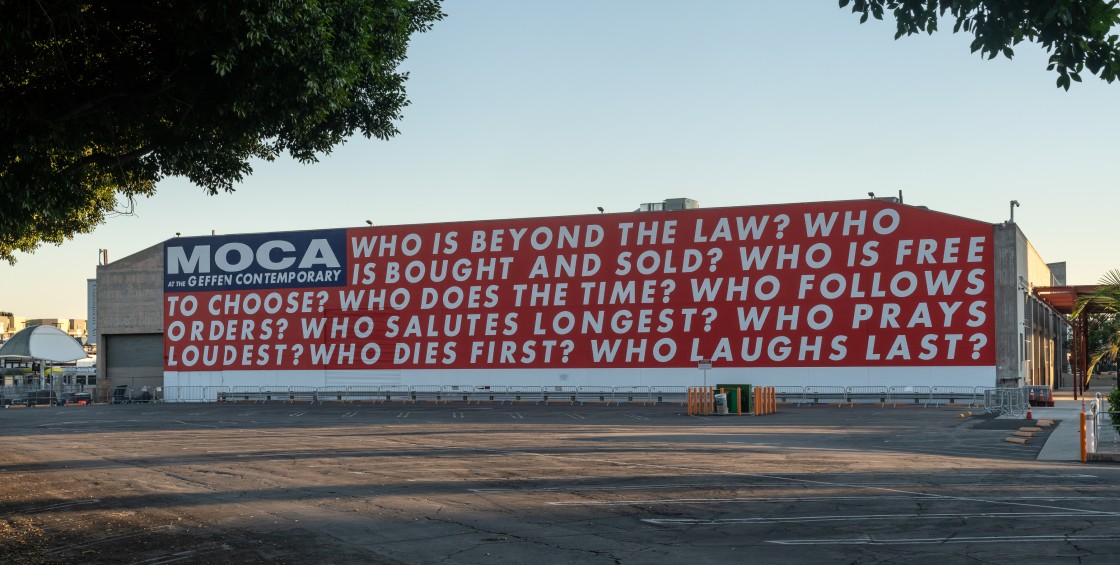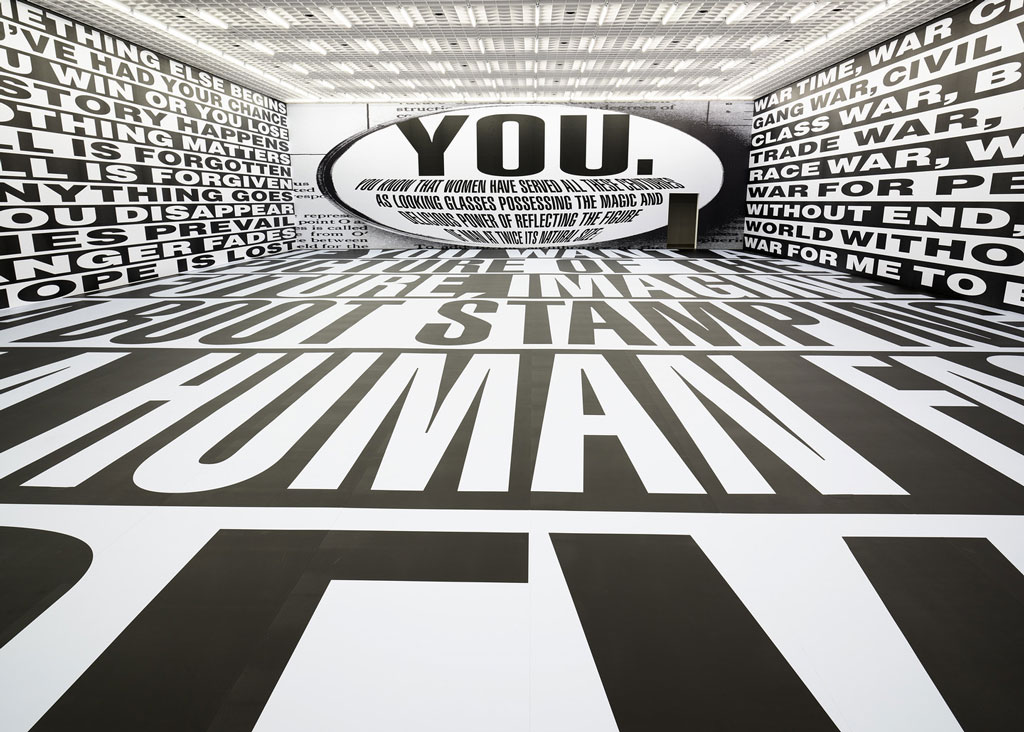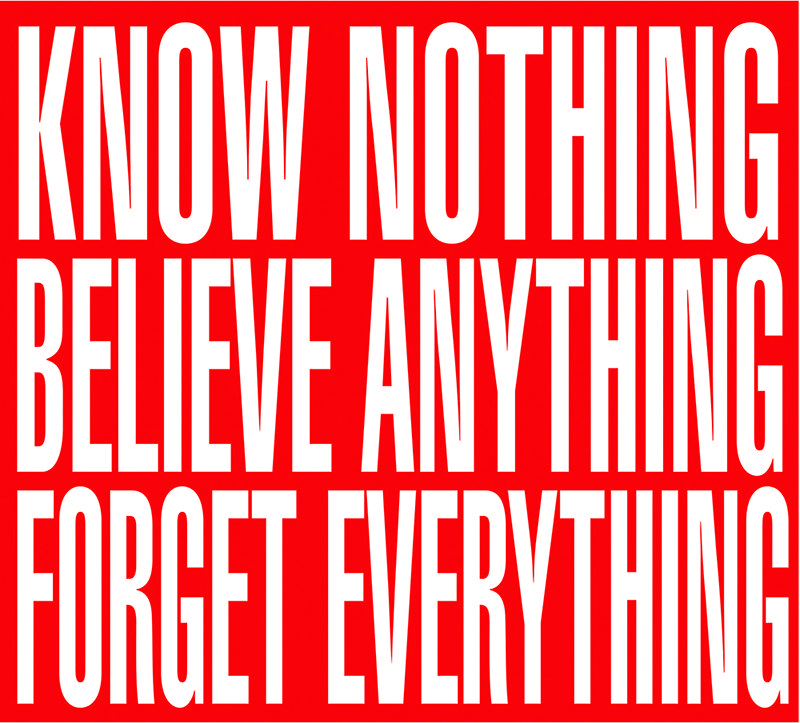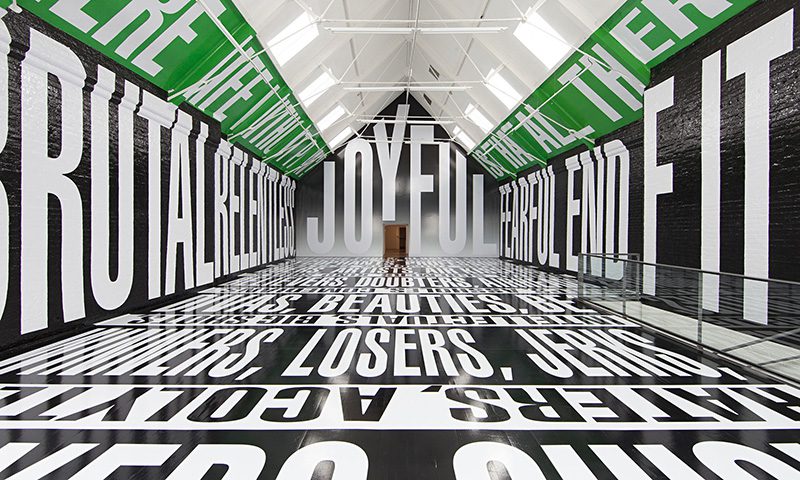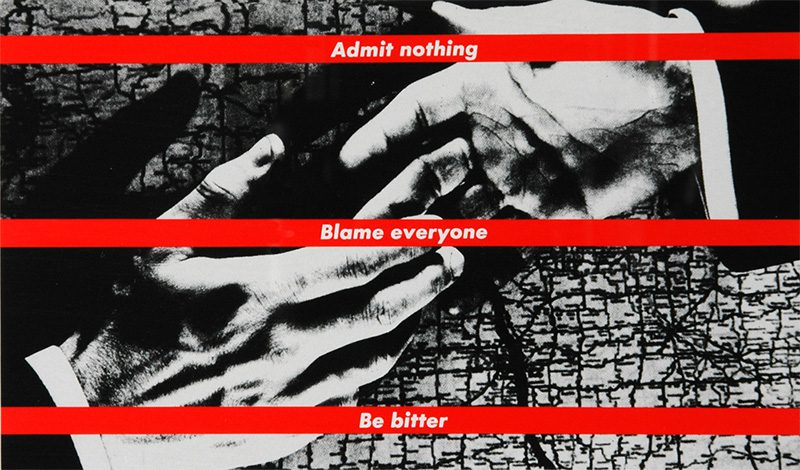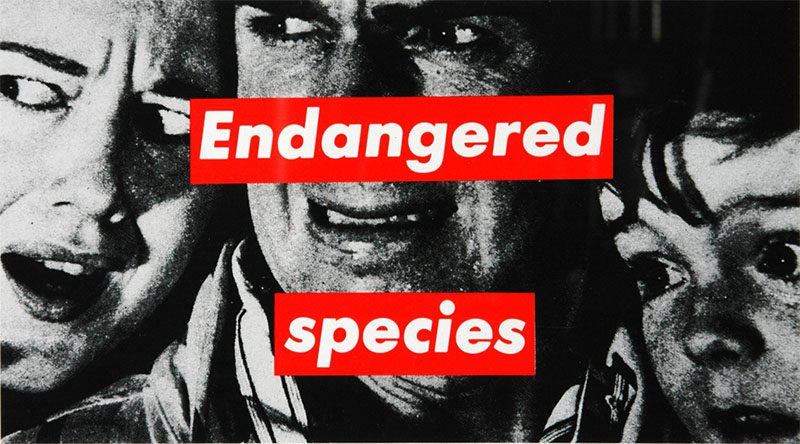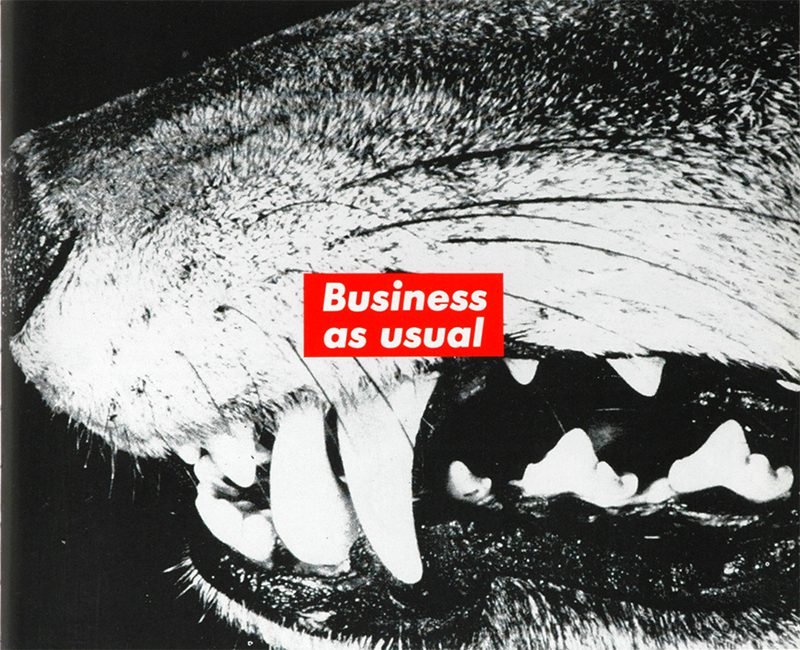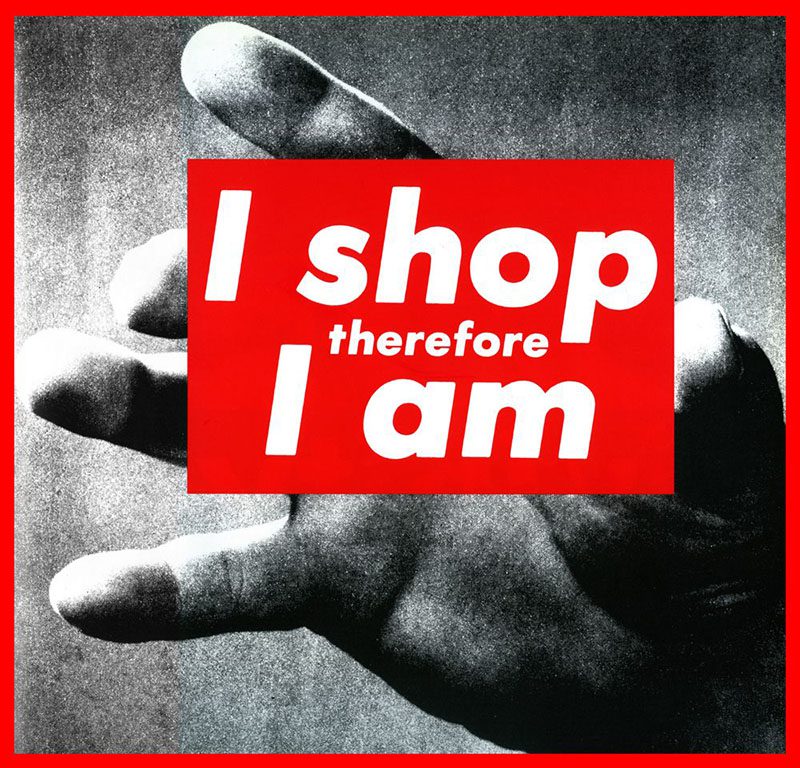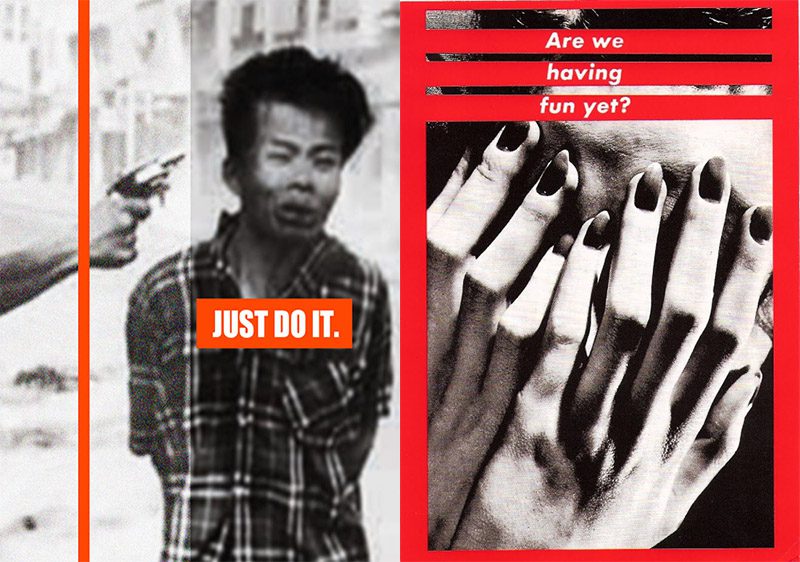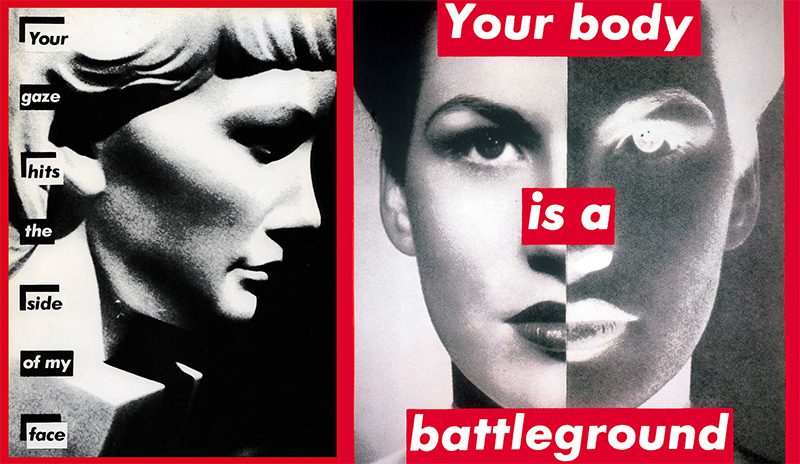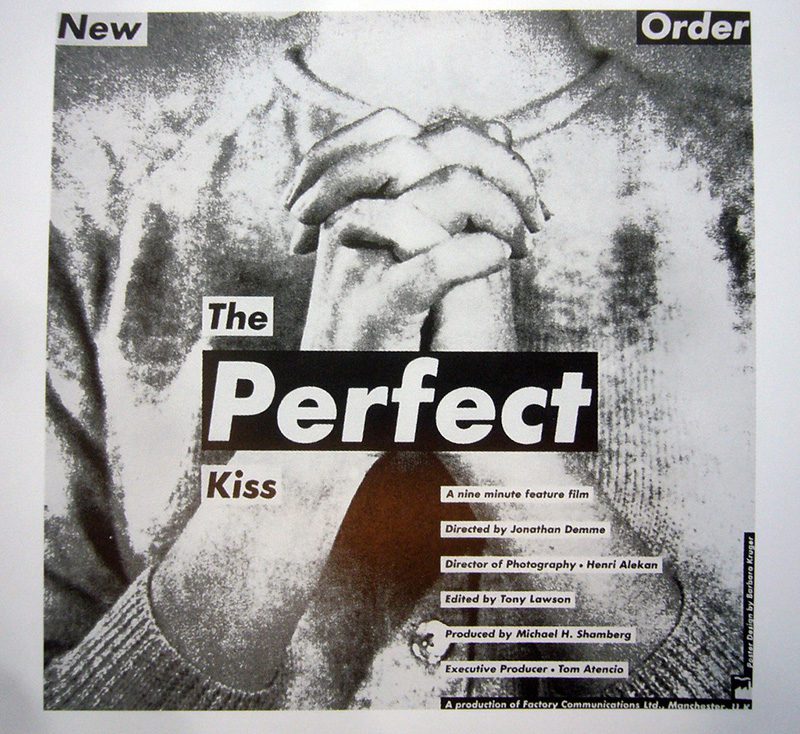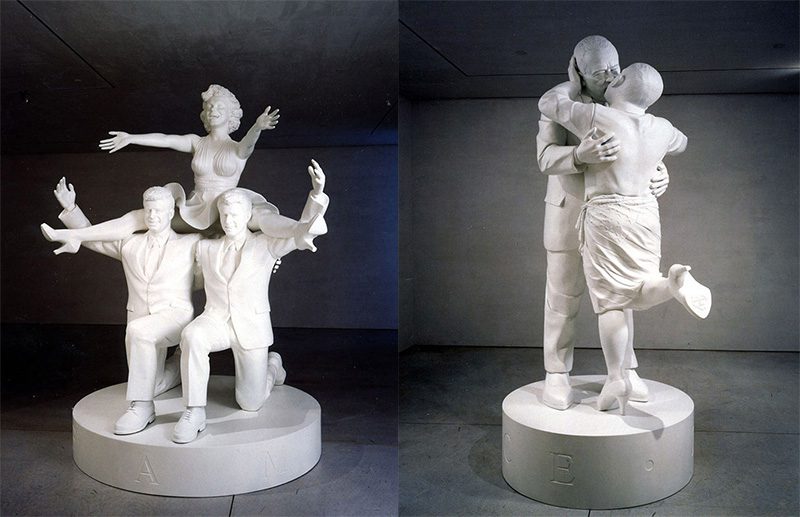TRACES: Barbara Kruger
 Today is the occasion to bear in mind the American Conceptual artist Barbara Kruger (26/1/1945- ), she layers found photographs from existing sources with pithy and aggressive text that involves the viewer in the struggle for power and control that her captions speak to. Much of her text questions the viewer about feminism, classicism, consumerism, and individual autonomy and desire. This column is a tribute to artists, living or dead, who have left their mark in Contemporary Art. Through documents or interviews, starting with: moments and memories, we reveal out from the past-unknown sides of big personalities, who left their indelible traces in time and history…
Today is the occasion to bear in mind the American Conceptual artist Barbara Kruger (26/1/1945- ), she layers found photographs from existing sources with pithy and aggressive text that involves the viewer in the struggle for power and control that her captions speak to. Much of her text questions the viewer about feminism, classicism, consumerism, and individual autonomy and desire. This column is a tribute to artists, living or dead, who have left their mark in Contemporary Art. Through documents or interviews, starting with: moments and memories, we reveal out from the past-unknown sides of big personalities, who left their indelible traces in time and history…
By Efi Michalarou
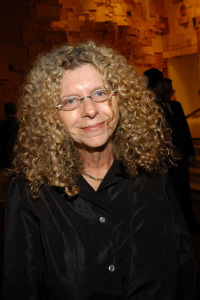 Barbara Kruger was born in Newark, New Jersey. After studying for a year at Syracuse she moved to New York where she began attending Parsons School of Design in 1965. She studied with Diane Arbus and Marvin Israel, who introduced Kruger to other photographers and fashion/magazine sub-cultures. After a year at Parsons, Kruger again left school and worked at Condi Nast Publications in 1966. Later sshe worked as a graphic designer, art director, and picture editor in the art departments at House and Garden, Aperture, and did magazine layouts, book jacket designs, and freelance picture editing for other publications. In her early years as a visual artist, Kruger crocheted, sewed and painted bright-hued and erotically suggestive objects, some of which were included by curator Marcia Tucker in the 1973 Whitney Biennial. Despite her inclusion in the Whitney Biennial and solo exhibitions at Artists Space and Fischbach Gallery, the following two years, she was dissatisfied with her output and its detachment from her growing social and political concerns. In the fall of 1976, Kruger abandoned art making and moved to Berkeley, where she taught at the University of California for four years and steeped herself in the writings of Walter Benjamin and Roland Barthes.She took up photography in 1977, producing a series of black-and-white details of architectural exteriors paired with her own textual ruminations on the lives of those living inside. Published as an artist’s book, “Picture/Readings” (1979) foreshadows the aesthetic vocabulary Kruger developed in her mature work. By 1979 Barbara Kruger stopped taking photographs and began to employ found images in her work, with words collaged directly over them. Her 1980 untitled piece commonly known as “Perfect” portrays the torso of a woman, hands clasped in prayer, evoking the Virgin Mary, the embodiment of submissive femininity;, the word perfect is emblazoned along the lower edge of the image. During the early 1980s Barbara Kruger perfected a signature agitprop style, using cropped, large-scale, black-and-white photographic images juxtaposed with raucous, pithy, and often ironic aphorisms, printed in Futura Bold typeface against black, white, or deep red text bars. The inclusion of personal pronouns in works like “Untitled (Your Gaze Hits the Side of My Face)” (1981) and “Untitled (I Shop Therefore I Am)” (1987) implicates viewers by confounding any clear notion of who is speaking. These rigorously composed mature works function successfully on any scale. In “Untitled (Your Body is a Battleground)” (1989,) a black and white photograph of a woman is displayed, but half of it (vertically) is displayed like a photography negative. The woman is facing the viewer, showing a perhaps oppositional gaze. This work was created in support of birth control rights, with abortion being a topical issue. Kruger is showing, through this work, that a woman’s body can literally be up for grabs unless someone fights for the right to do what they want with their own body. In 1990, Kruger scandalized the Japanese American community of Little Tokyo, Los Angeles, with her proposal to paint the Pledge of Allegiance, bordered by provocative questions, on the side of a warehouse in the heart of the historic downtown neighborhood. In recent years Barbara Kruger has extended her aesthetic project, creating public installations of her work in galleries, museums, municipal buildings, train stations, and parks, as well as on buses and billboards around the world. Walls, floors, and ceilings are covered with images and texts, which engulf and even assault the viewer. Since the late 1990s, Kruger has incorporated sculpture into her ongoing critique of modern American culture. “Justice” (1997), in white-painted fiberglass, depicts J. Edgar Hoover and Roy Cohn two right-wing public figures who hid their homosexuality in partial drag, kissing one another. In this kitsch send-up of commemorative statuary, Kruger highlights the conspiracy of silence that enabled these two men to accrue social and political power. As part of the Venice Biennale in 2005, Kruger (Golden Lion for Lifetime Achievement), installed a digitally printed vinyl mural across the entire facade of the Italian pavilion, dividing it into three parts: green at the left, red at the right, white in between. In English and Italian, the words “money” and “power” climbed the portico’s columns; the left wall said, “Pretend things are going as planned”, while “God is on my side he told me so” fills the right. In 2012, as a member of the board of the Museum of Contemporary Art, Los Angeles (MOCA), Kruger volunteered to be the lead funder of the museum’s scholarly exhibit “Ends of the Earth: Land Art to 1974” and to create a new work on vinyl to sell with proceeds going entirely toward the exhibitions budget.
Barbara Kruger was born in Newark, New Jersey. After studying for a year at Syracuse she moved to New York where she began attending Parsons School of Design in 1965. She studied with Diane Arbus and Marvin Israel, who introduced Kruger to other photographers and fashion/magazine sub-cultures. After a year at Parsons, Kruger again left school and worked at Condi Nast Publications in 1966. Later sshe worked as a graphic designer, art director, and picture editor in the art departments at House and Garden, Aperture, and did magazine layouts, book jacket designs, and freelance picture editing for other publications. In her early years as a visual artist, Kruger crocheted, sewed and painted bright-hued and erotically suggestive objects, some of which were included by curator Marcia Tucker in the 1973 Whitney Biennial. Despite her inclusion in the Whitney Biennial and solo exhibitions at Artists Space and Fischbach Gallery, the following two years, she was dissatisfied with her output and its detachment from her growing social and political concerns. In the fall of 1976, Kruger abandoned art making and moved to Berkeley, where she taught at the University of California for four years and steeped herself in the writings of Walter Benjamin and Roland Barthes.She took up photography in 1977, producing a series of black-and-white details of architectural exteriors paired with her own textual ruminations on the lives of those living inside. Published as an artist’s book, “Picture/Readings” (1979) foreshadows the aesthetic vocabulary Kruger developed in her mature work. By 1979 Barbara Kruger stopped taking photographs and began to employ found images in her work, with words collaged directly over them. Her 1980 untitled piece commonly known as “Perfect” portrays the torso of a woman, hands clasped in prayer, evoking the Virgin Mary, the embodiment of submissive femininity;, the word perfect is emblazoned along the lower edge of the image. During the early 1980s Barbara Kruger perfected a signature agitprop style, using cropped, large-scale, black-and-white photographic images juxtaposed with raucous, pithy, and often ironic aphorisms, printed in Futura Bold typeface against black, white, or deep red text bars. The inclusion of personal pronouns in works like “Untitled (Your Gaze Hits the Side of My Face)” (1981) and “Untitled (I Shop Therefore I Am)” (1987) implicates viewers by confounding any clear notion of who is speaking. These rigorously composed mature works function successfully on any scale. In “Untitled (Your Body is a Battleground)” (1989,) a black and white photograph of a woman is displayed, but half of it (vertically) is displayed like a photography negative. The woman is facing the viewer, showing a perhaps oppositional gaze. This work was created in support of birth control rights, with abortion being a topical issue. Kruger is showing, through this work, that a woman’s body can literally be up for grabs unless someone fights for the right to do what they want with their own body. In 1990, Kruger scandalized the Japanese American community of Little Tokyo, Los Angeles, with her proposal to paint the Pledge of Allegiance, bordered by provocative questions, on the side of a warehouse in the heart of the historic downtown neighborhood. In recent years Barbara Kruger has extended her aesthetic project, creating public installations of her work in galleries, museums, municipal buildings, train stations, and parks, as well as on buses and billboards around the world. Walls, floors, and ceilings are covered with images and texts, which engulf and even assault the viewer. Since the late 1990s, Kruger has incorporated sculpture into her ongoing critique of modern American culture. “Justice” (1997), in white-painted fiberglass, depicts J. Edgar Hoover and Roy Cohn two right-wing public figures who hid their homosexuality in partial drag, kissing one another. In this kitsch send-up of commemorative statuary, Kruger highlights the conspiracy of silence that enabled these two men to accrue social and political power. As part of the Venice Biennale in 2005, Kruger (Golden Lion for Lifetime Achievement), installed a digitally printed vinyl mural across the entire facade of the Italian pavilion, dividing it into three parts: green at the left, red at the right, white in between. In English and Italian, the words “money” and “power” climbed the portico’s columns; the left wall said, “Pretend things are going as planned”, while “God is on my side he told me so” fills the right. In 2012, as a member of the board of the Museum of Contemporary Art, Los Angeles (MOCA), Kruger volunteered to be the lead funder of the museum’s scholarly exhibit “Ends of the Earth: Land Art to 1974” and to create a new work on vinyl to sell with proceeds going entirely toward the exhibitions budget. 